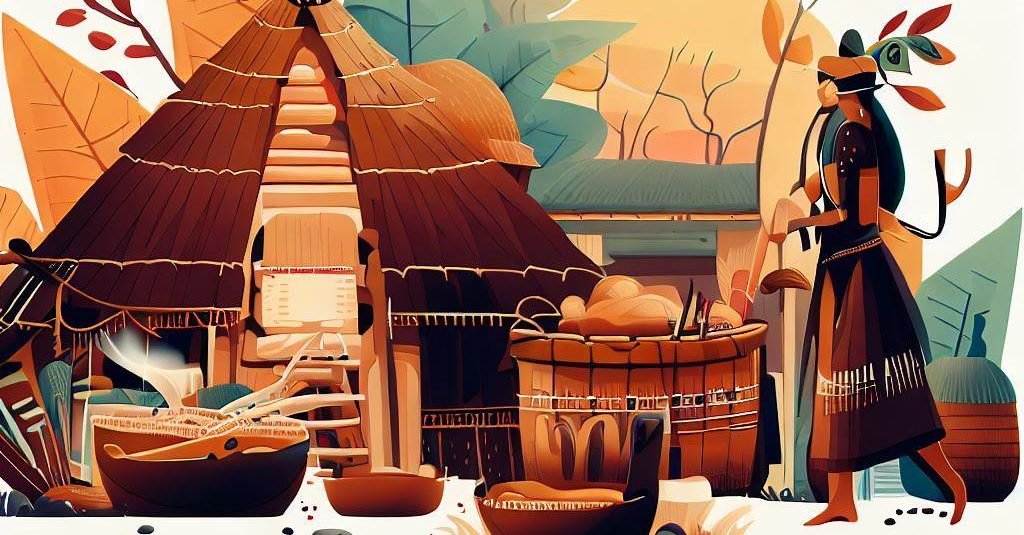Cherokee Culture: An Exploration of Interconnected Histories, Cultures, and Experiences
The Cherokee people have a rich and diverse culture, deeply rooted in the interconnected histories and experiences of Native Americans. This article aims to explore various aspects of Cherokee culture, highlighting the unique artistic, spiritual, and linguistic traditions that define the Cherokee Nation. It will also discuss the significance of interactions with other tribes, European colonizers, and the impact of historical events, such as the Trail of Tears, in shaping the development of Cherokee culture.
Interactions with Other Tribes, European Colonizers, and the Impact of Historical Events on Cherokee Culture
Throughout history, Cherokee culture has been shaped by interactions with other tribes, European colonizers, and the impact of historical events such as the Trail of Tears. These encounters have influenced various aspects of Cherokee life, from their social structures and political alliances to their arts, language, and spiritual practices.
Intertribal relations played a significant role in the development of Cherokee culture. The Cherokee people had both friendly and hostile interactions with neighboring tribes, such as the Creek, Choctaw, Chickasaw, and Shawnee. Trade, intermarriage, and cultural exchange between these tribes contributed to the development of a shared regional identity, while also fostering the spread of ideas and practices.
The arrival of European colonizers in the late 15th and early 16th centuries had a profound impact on Cherokee culture. European settlers introduced new technologies, materials, and trade goods that influenced Cherokee art, clothing, and daily life. However, these encounters also brought devastating consequences, including the introduction of diseases, forced conversion to Christianity, and violent conflicts that led to significant loss of life and territory.
The Trail of Tears, a forced relocation of the Cherokee people from their ancestral lands in the southeastern United States to present-day Oklahoma, had a lasting impact on Cherokee culture. This tragic event resulted in the death of thousands of Cherokee people and the fragmentation of their communities. The Trail of Tears marked a turning point in Cherokee history, as the nation grappled with the challenges of rebuilding their communities, preserving their traditions, and adapting to new environments and circumstances.
Despite these challenges, the Cherokee people have demonstrated remarkable resilience and adaptability, preserving and adapting their cultural practices in the face of adversity. The interactions with other tribes and European colonizers, as well as the impact of historical events such as the Trail of Tears, have shaped the development of Cherokee culture, contributing to the rich tapestry of interconnected histories, experiences, and traditions that define the Cherokee Nation today.
Traditional and Contemporary Cherokee Art and Craftsmanship
Cherokee art is deeply intertwined with the people’s connection to the natural world and spiritual beliefs. Traditional Cherokee art includes pottery, basket and finger weaving, stone and wood carving, and bead work. These crafts are more than just utilitarian; they also serve as expressions of Cherokee culture and history, often featuring intricate designs and symbols that convey stories, beliefs, and values. In contemporary Cherokee art, artists have adapted and innovated traditional techniques, blending them with modern styles and materials to create unique, dynamic works that reflect the evolving Cherokee culture.
Cherokee Pottery, Basket Weaving Techniques, and Contemporary Innovations
Cherokee pottery is known for its beautiful forms, often adorned with intricate geometric patterns and animal designs. Traditionally, women were responsible for pottery-making, using locally sourced clay and coiling techniques to create a variety of vessels, from bowls to jars. They would then smooth and polish the surface, adding decorations before firing the pottery in a wood-fueled kiln. Contemporary Cherokee potters have expanded upon these traditional techniques, incorporating new materials and exploring innovative designs while preserving the cultural significance of their craft.
Basket weaving is another revered Cherokee art form. Using materials like white oak, hickory, and river cane, Cherokee weavers create intricate baskets that are both functional and decorative. The double-weave technique, in which the basket is woven inside and out, is a signature Cherokee style, resulting in sturdy, durable baskets that are valued for their beauty and utility. Modern Cherokee basket weavers have experimented with new materials and patterns, pushing the boundaries of their art form while maintaining a strong connection to their cultural heritage.
The Role of Storytelling in Cherokee Culture and its Evolution
Storytelling is an essential aspect of Cherokee culture, serving to preserve history, convey spiritual beliefs, and teach important life lessons. Cherokee stories often feature animals as central characters, with anthropomorphic qualities that reflect human traits and values. These stories are passed down through generations, preserving traditional knowledge and ensuring the continuity of Cherokee culture. In recent years, Cherokee storytellers have adapted traditional stories to various media, such as books, films, and digital platforms, ensuring their continued relevance and resonance with modern audiences.
Traditional and Contemporary Cherokee Music and Dance
Music and dance are vital components of Cherokee culture, used in various ceremonies and celebrations. Traditional Cherokee music consists of percussion instruments, like drums and rattles, accompanied by singing and chanting. The songs often carry spiritual and cultural significance, and many are specific to particular ceremonies and events.
Cherokee dances have both social and ceremonial functions, with dances like the Stomp Dance and the Bear Dance serving as important community gatherings and expressions of spiritual beliefs. These dances are characterized by their communal nature, with participants often forming circles or lines and moving in unison to the rhythm of the music.
In recent years, contemporary Cherokee musicians and dancers have incorporated modern instruments, styles, and choreography into their performances, showcasing the adaptability and resilience of Cherokee culture in the face of change and challenges.
The Spiritual Beliefs and Practices of the Cherokee People: Adapting to Modern Times
Cherokee spirituality is deeply connected to the natural world, with an emphasis on the interconnectedness of all living things. The Cherokee people believe in a supreme being, known as the Great Spirit, as well as a host of lesser spirits and beings that inhabit the natural world. Rituals, ceremonies, and prayers form an essential part of Cherokee spiritual life, providing a means to communicate with these spiritual beings and maintain harmony with the natural world.
As Cherokee people adapt to modern life, their spiritual practices have also evolved, incorporating new rituals and ceremonies that address contemporary concerns and challenges. At the same time, traditional spiritual practices, such as the Green Corn Ceremony, continue to play an important role in Cherokee life, demonstrating the enduring strength and adaptability of Cherokee spirituality.
The Cherokee Language: Revitalization and Integration in Modern Society
The Cherokee language is a vital component of Cherokee culture and identity. It is a member of the Iroquoian language family and is unique for its syllabary, invented by Sequoyah in the early 19th century. The Cherokee syllabary allowed the Cherokee people to develop a written language, resulting in widespread literacy and a rich literary tradition.
Efforts to preserve the Cherokee language have been ongoing for decades, as the number of fluent speakers has declined due to factors such as forced assimilation and displacement. Language revitalization programs, including immersion schools and online resources, have been established to encourage the learning and use of the Cherokee language, ensuring its survival for future generations. Additionally, efforts to integrate the Cherokee language into modern technology, such as smartphone apps and computer programs, have helped to make the language more accessible and relevant to younger generations.
The Role of Clans in Cherokee Society: Balancing Tradition and Modernity
Clans play a central role in Cherokee society, serving as the primary social, political, and kinship units. Traditionally, there are seven Cherokee clans: Bird, Paint, Deer, Long Hair, Wild Potato, Blue, and Wolf. Clan membership is matrilineal, meaning that an individual belongs to the same clan as their mother. Clans are responsible for various aspects of community life, including the administration of justice, care for the elderly, and organizing ceremonies and events.
While the traditional clan system remains an important aspect of Cherokee life, it has adapted to the realities of modern society, with clans taking on new roles and responsibilities as needed. This balance between tradition and modernity is emblematic of the resilience and adaptability of Cherokee culture as a whole.
Traditional and Modern Cherokee Clothing and Adornment
Cherokee clothing is characterized by its practicality and adaptability, reflecting the people’s close relationship with the natural world. Traditionally, Cherokee men wore breechcloths and leggings, while women wore wraparound skirts and poncho-style tops. Clothing was often decorated with beads, shells, and intricate embroidery, demonstrating the wearer’s skill and artistry.
Cherokee adornment also included items such as earrings, necklaces, and hair ornaments, made from materials like bone, copper, and shell. These accessories served both aesthetic and symbolic purposes, often carrying spiritual or cultural significance.
In contemporary Cherokee fashion, designers and artisans have embraced both traditional and modern styles, incorporating traditional materials and motifs into innovative designs that reflect the evolving nature of Cherokee culture.
The Importance of Sports and Games in Cherokee Culture: Tradition and Adaptation
Sports and games are an essential part of Cherokee culture, fostering community bonds and promoting physical fitness. Traditional Cherokee games include stickball, marbles, and chunkey, a game played with stone disks and long poles. Stickball, in particular, holds great cultural significance, as it is often played during community events and has deep spiritual and historical roots.
In recent years, the Cherokee people have adapted and incorporated modern sports and games into their cultural practices, demonstrating the adaptability of Cherokee culture in the face of change. By participating in both traditional and contemporary sports, the Cherokee people maintain a connection to their heritage while embracing the benefits of physical activity and friendly competition in the modern world.
Conclusion
Cherokee culture is a complex and diverse tapestry, woven from the interconnected histories, experiences, and spiritual beliefs of the Cherokee people. From traditional arts and crafts to linguistic and spiritual practices, the Cherokee Nation continues to preserve and celebrate its unique cultural heritage while adapting to the challenges and opportunities of the modern world. Understanding and appreciating the rich traditions and values of the Cherokee people is crucial for fostering a greater understanding of Native American interconnected histories, cultures, and experiences. By acknowledging the importance of both traditional and contemporary elements, we can gain a deeper appreciation for the resilience and adaptability that define Cherokee culture.
Further Reading
- Conley, R. J. (2007). Cherokee Thoughts: Honest and Uncensored. Norman, OK: University of Oklahoma Press.
- Duncan, B. R. (1998). Living Stories of the Cherokee. Chapel Hill, NC: University of North Carolina Press.
- Duncan, B. R., & Riggs, B. (2003). Cherokee Heritage Trails Guidebook. Chapel Hill, NC: University of North Carolina Press.
- Mooney, J. (2018). Myths of the Cherokee. Madison & Adams Press.
- Perdue, T., & Green, M. D. (2005). The Cherokee Nation and the Trail of Tears. New York, NY: Penguin.
- Perdue, T. (1999). Cherokee Women: Gender and Culture Change, 1700-1835. Lincoln, NE: University of Nebraska Press.
- Reed, J. D. (2005). Cherokee Pottery: From the Hands of Our Elders. Charleston, SC: The History Press.

